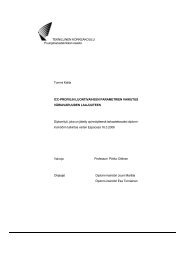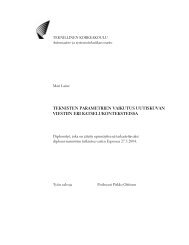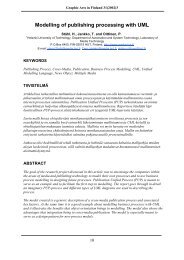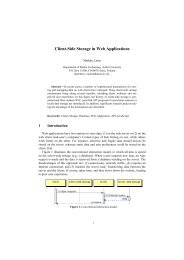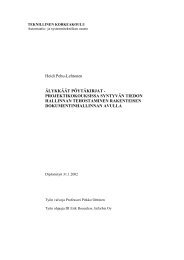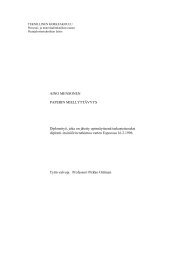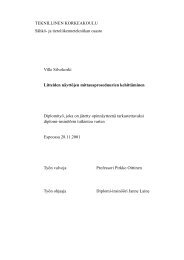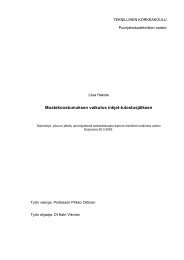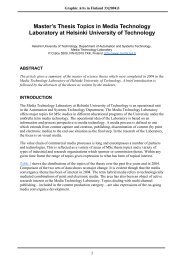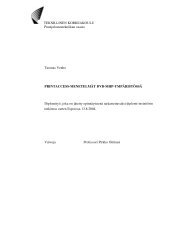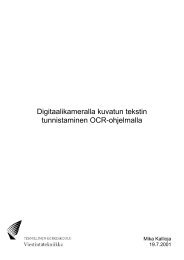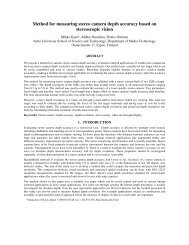M.Sc. Theses 2010 – Part 1 - TKK
M.Sc. Theses 2010 – Part 1 - TKK
M.Sc. Theses 2010 – Part 1 - TKK
You also want an ePaper? Increase the reach of your titles
YUMPU automatically turns print PDFs into web optimized ePapers that Google loves.
Graphic Arts in Finland 39(<strong>2010</strong>)1<br />
M.<strong>Sc</strong>. <strong>Theses</strong> <strong>2010</strong> <strong>–</strong> <strong>Part</strong> 1<br />
Aalto University, <strong>Sc</strong>hool of <strong>Sc</strong>ience and Technology, Faculty of Information and Natural <strong>Sc</strong>iences,<br />
Department of Media Technology<br />
P.O.Box 15500, FIN-00076 Aalto, Finland, http://media.tkk.fi<br />
INTRODUCTION<br />
This is a collection of abstracts of M.<strong>Sc</strong>. theses completed and approved in professorship no. 75<br />
at the Department of Media Technology the first months of <strong>2010</strong>. The professor's chair is the<br />
75th professorship established at Helsinki University of Technology since it was founded in<br />
1908. It was created in 1967 to take responsibility of education and research in graphic arts<br />
technology. In <strong>2010</strong> two professors operate under the code of the professorship. Professor Eero<br />
Hyvönen specializes in web technologies and professor Pirkko Oittinen in visual media. The<br />
scope of the theses fot the degree of M.<strong>Sc</strong>. in engineering which they supervise is yet broader as<br />
is evident from the abstracts.<br />
The abstracts and keywords published below have been extracted from the theses without<br />
editing. Some of the theses are available on-line as pdf's. Links are given when this in the case.<br />
Ahlqvist-Lehkosuo, Liisa, "The Mapping and Development of Processes in a Media<br />
House", M.<strong>Sc</strong>. Thesis <strong>2010</strong>, 55+13 pages (original language: Finnish,<br />
"Mediasuunnittelun prosessien mallintaminen ja kehittäminen").<br />
Abstract<br />
The development of processes can focus on just one work phase or it can cover the whole<br />
process. In any case the mapping of the current process will be the starting point for the<br />
development.<br />
In this Thesis models were developed for the processes and tasks of a media house including<br />
media planning, capacity control, traffic and trailers. Overlapping and unnecessary work<br />
phases were identified and eliminated, the process for the media planning was simplified and<br />
the process to control the advertising campaigns was improved.<br />
The improvement of the process will require an optimization of the work force and other<br />
resources, better defined responsibilities for the processes, a smooth workload for all workers,<br />
constant performance, elimination of errors and a well running system for back-up work<br />
force.<br />
Splitting the whole process into subprocesses and work descriptions started the mapping of<br />
the process. The existing overlaps were removed. Every subprocess was described in the same<br />
format and they were divided into different categories. A complete process map of the current<br />
process was developed.<br />
Bottlenecks in the current processes and forces influencing the needed changes were<br />
identified and proposals were made for further development. As a result of the development<br />
project, a new process map was developed including work flow charts of the subprocesses. A<br />
new organization model was also developed. .<br />
Keywords: process, media planning, control of capacity, trafic<br />
29
Graphic Arts in Finland 39(<strong>2010</strong>)1<br />
Haggrén-Arkoma, Elisa, "Digital Asset Management System Implementation in a<br />
Distance Sales Company", M.<strong>Sc</strong>. Thesis <strong>2010</strong>, 84 pages (original language: Finnish,<br />
"Digitaalisen aineistonhallintajärjestelmän käyttöönotto etämyyntiyrityksessä").<br />
Abstract<br />
The purpose of this thesis was to investigate the effects which could be achieved when<br />
implementing a digital asset management system in a distance sales company, especially the<br />
effects to the processes and the process quality.<br />
In the literature survey processes and process quality are examined. The current situation and<br />
trends of marketing and especially direct marketing and management and lifecycle of digital<br />
assets are studied. Digital asset management systems are introduced: what they are and what<br />
kind of opportunities can arise to a company when implementing a digital asset management<br />
system.<br />
In the empirical part of the thesis the target company’s catalogue production and publishing<br />
processes were investigated. First the employees of the marketing department were<br />
interviewed. Based on these interviews three processes were modeled: catalogue production<br />
process, image process and text process. After implementing the digital asset management<br />
system the same roles were interviewed and the same processes were modeled again.<br />
Conclusions about the impact of the implementation were drawn by comparing the old and the<br />
new process models and the results of the interviews. The results were also compared to the<br />
theory presented in the literature survey.<br />
Implementing a digital asset management system was profitable since remarkable time and<br />
cost savings were achieved in some processes and parts of the processes. The theory and the<br />
practice did meet quite well and the process quality was improved after the implementation.<br />
However, there are also some process parts that should be investigated for further<br />
development.<br />
Keywords: DAM, digital asset management, distance sales, process quality, publishing<br />
processes<br />
Kuhna, Mikko, "Method for Evaluating Tone Mapping Operators for Natural High<br />
Dynamic Range Images", M.<strong>Sc</strong>. Thesis <strong>2010</strong>, 114+39 pages.<br />
Abstract<br />
The thesis focused on the determination of image quality from tone mapped natural high<br />
dynamic range images. The first aim of the study was to define a method for capturing<br />
colorimetric high dynamic range images. The second aim was to estimate the image quality of<br />
tone mapped images with subjective and objective methods.<br />
A total of 55 colorimetric high dynamic range images were photographed, five of which were<br />
selected as test images of the study. Test images were photographed based on guidelines for<br />
good test images. Most importantly, all images contain characteristics, such as objects with<br />
memory colors, to facilitate image quality evaluation without a reference.<br />
Altogether 25 tone mapping methods were selected for evaluation. The used psychometric<br />
method consisted of two stages. In the first stage, the tone mapping methods were reduced to<br />
seven for to be evaluated more profoundly. In the second stage, these seven methods were<br />
evaluated based on image naturalness and visual pleasantness with subjective tests by 28<br />
30
Graphic Arts in Finland 39(<strong>2010</strong>)1<br />
participants. The performance of objective image quality assessment methods was also tested<br />
with the test images.<br />
Computationally simpler global tone mapping methods were found to perform the best,<br />
although image content played a significant role in the results. It was also concluded that<br />
current objective image quality assessment methods are not suited for high dynamic range<br />
images.<br />
Keywords: HDR, HDRI, image quality, dynamic range, camera characterization, tone<br />
mapping, subjective evaluation<br />
Kuittinen, Henna, "Web Solution Concept for Targeted Multichannel Marketing<br />
Communication", M.<strong>Sc</strong>. Thesis <strong>2010</strong>, 104+48 pages (original language: Finnish,<br />
"Verkkopalvelukonsepti kohdennettuun monikanavaiseen markkinointiviestintään").<br />
Abstract<br />
The objective of the study was to identify the future improvements of the current web solution<br />
and to describe the new web solution concept containing these improvements. The current<br />
web solution that is the object of the study is used for designing and sending digitally printed<br />
or emailed direct marketing messages.<br />
In the study the present state of the web solution was first described. Then web solution<br />
improvement needs were identified based on the theory examination and quantitative<br />
questionnaire survey. The study question to be examined was: what kind of is the optimal web<br />
solution to the targeted marketing communication. In the theory part the optimal web solution<br />
features were identified based on the marketing communication trend examination.<br />
Furthermore, features for the optimal web solution were identified based on the questionnaire<br />
survey results. With the questionnaire survey differences of BtoB and BtoC marketers were<br />
also studied. The concept of web solution, which takes the identified properties into<br />
consideration, was described as a final result of the study.<br />
The identified main improvements of the web solution were related to the availability of the<br />
data, customer-oriented marketing, channel selection, management tools and measurements.<br />
The final concept of the web solution contained the following main features: data warehouse,<br />
follow-up, campaign automation, targeting, digital asset management and channels. Data<br />
warehouse was needed to collect and analyze the customer information from multiple data<br />
sources. Follow-up tools were needed to produce customer reports, campaign reports and<br />
reports of the marketing results.<br />
With the campaign automation tools the creation and management of automated campaigns<br />
were made possible and the targeting tools were needed to implement one-to-one and trigger<br />
marketing. The digital asset management added the tools for the centralized storing and<br />
management of materials. To reach real multichannel marketing the channel selection of the<br />
web solution was expanded by adding a mobile marketing and the internet marketing steering<br />
with the printed and emailed direct marketing.<br />
Keywords: marketing communication, direct marketing, web solution, web-to-print, targeting,<br />
multichannel marketing<br />
31
Graphic Arts in Finland 39(<strong>2010</strong>)1<br />
Papula, Ville "Information Quality in Service Production Process", M.<strong>Sc</strong>. Thesis<br />
<strong>2010</strong>, 78+25 pages (original language: Finnish, "Informaation laatu<br />
palveluntuotantoprosessissa").<br />
Abstract<br />
During the development of management information systems (MIS), there is a general lack of<br />
attention paid to information quality (IQ). The management information system itself has a<br />
significant impact on the quality of information that maintains the entire production process.<br />
Assessment of IQ is never straightforward and in practice the methods have to be developed<br />
on a case by case basis.<br />
In this master’s thesis the assessment and development of IQ has been approached from the<br />
perspective of a service production process. The study aimed to develop a method of<br />
assessing IQ that could be applied to the case company’s service processes. The thesis was<br />
carried out in parallel to the development project of MIS in the case company. The second<br />
goal and contribution to the MIS development project, was to provide a theoretical basis for<br />
the development of the new MIS and testing of its functionality considering IQ. The point of<br />
the study was to show if the quality of information improved as the result of the development<br />
project or not.The method developed for assessing the IQ was the result of the study of<br />
published literature.<br />
The method itself was based on a subjective test in which the test subjects (case company<br />
employees) assessed the quality of information during the stage of the production process in<br />
which they were involved. More specifically, subjects assessed the quality of information of<br />
given parameters, e.g. completeness, accessibility, relevancy etc. The thesis also developed a<br />
method for locating information quality problem areas in the process. The method is based on<br />
the monitoring of the relative amount of failures in internal transactions of the information<br />
process. The internal transaction means the transfer of a task between two stages of a process.<br />
The transaction is considered a failure if the latter stage of a process cannot perform its task<br />
with the information at hand. Missing information causes the process to move backwards to<br />
get the information needed and the task completed.<br />
The most important result of this thesis was the method for IQ assessment that was based on<br />
the literature study and the successful exploitation of the method in the case study. From the<br />
results of the case study it was concluded that the IQ improved in the service prosesses of the<br />
case company. The case study produced an innovation, which resulted in an improved model<br />
for assessing the quality of information in the service production process. The proposed model<br />
combined the concept of information as a product and quality aspects of information.<br />
Keywords: information quality, IQ, information, quality, service business process,<br />
management information system<br />
Peltola, Taina, "Rationalization of the Workflow in an Order Based Printing<br />
House", M.<strong>Sc</strong>. Thesis <strong>2010</strong>, 66 pages (original language: Finnish, "Tilauskirjapainon<br />
työnkulun tehostaminen").<br />
Abstract<br />
This thesis studied rationalization of the workflow in an order based printing house focusing<br />
especially on the interfaces between sales, production management and production. The<br />
workflow is seen in this case as an order fulfillment process, which includes activities from<br />
receiving the order to delivery of products or services. The objective of workflow<br />
32
Graphic Arts in Finland 39(<strong>2010</strong>)1<br />
rationalization is to discover new, more efficient work habits, to ensure that deliveries are on<br />
time, to clarify the division of responsibilities, and to reduce quality costs.<br />
The present state of the workflow and its improvement needs was estimated based on the<br />
interviews, observations, and group discussions. In this study, soft systems methodology<br />
(SSM) was used as a research method. SSM is a flexible and versatile group of methods to<br />
consistently change, develop, and improve human activity systems.<br />
A new enterprise resource planning system and a decrease in human resources even though<br />
the amount of work has stayed the same, has created major challenges in workflow. The entire<br />
workflow needs more accurate and responsible approach while multiple skills are also needed.<br />
Handling quality issues depend too much on the supervisors of each department, which results<br />
in significant differences between departments.<br />
The majority of the perceived problems only required agreed, mutual procedures, which then<br />
should also be followed. Measuring lead-times of the printing jobs is also recommended. This<br />
Thesis includes instructions on how to measure the effects of the implemented improvements,<br />
using mainly the existing indicators. The suitability of the methodology itself for this Thesis<br />
was also reviewed briefly.<br />
Keywords: development of an order fulfillment process, systems thinking, soft systems<br />
methodology (SSM)<br />
Sulanto, Saara, "Evaluation of a Multifaceted Image Categorization Model", M.<strong>Sc</strong>.<br />
Thesis <strong>2010</strong>, 71+22 pages.<br />
Abstract<br />
The aim of this master’s thesis was to evaluate a multifaceted image categorization model in<br />
practical use. The study focused on how subjects categorized images using the model, what<br />
classes were used, how often, and how consistent was the use of classes between subjects. The<br />
subjects were also asked to provide their view on the model, and what was easy or difficult in<br />
the categorization. The thesis presents methods from earlier image categorization and<br />
indexing research, some of which were used in this study. The results from the previous<br />
research were compared to the applicable parts of this study.<br />
The categorization model was tested with 24 journalism professionals. They were given a task<br />
to categorize 20 images using the existing multifaceted image categorization model. The<br />
essential difference to many earlier studies was that with multifaceted categorization, the<br />
images could be categorized into more than one relevant classes.<br />
The main discovery was that the categorization model is useful in practical situation. It can be<br />
applied to at least portraits, scenery and object images. Image functions were often assigned to<br />
images, as well as themes. Descriptive main classes were used less, and they were considered<br />
difficult. The subjects assigned categories to images rather consistently.<br />
According to the results, the categorization model was improved and applied to a prototype<br />
image retrieval program (Valopöytä). Finally, ten thousand images were categorized and<br />
archived using the improved model.<br />
Keywords: multifaceted image categorization, image categorization models, image retrieval,<br />
image similarity<br />
33
Graphic Arts in Finland 39(<strong>2010</strong>)1<br />
Valkonen, Valtteri, "Performance of No-Reference Quality Metrics for Measuring<br />
Subjective Quality of Mobile Camera Video", M.<strong>Sc</strong>. Thesis <strong>2010</strong>, 98 pages.<br />
Abstract<br />
In this thesis, the performance of different no-reference (NR) quality metrics in context of<br />
natural mobile video was studied. Pre-existing and proposed metrics, based on existing ones,<br />
were used. In order to evaluate the performance of the metrics, a subjective quality space and<br />
dimensions for each of the three natural video contents were formed on the basis of<br />
preexisting and available data. Individual NR metric results were compared to the formed<br />
dimensions that the metric is designed to estimate.<br />
The literature section of the thesis describes the basics of image quality and properties of<br />
different quality metric types. The process of capturing digital video, as well as different<br />
distortions introduced by the process, are explained. Finally, different NR metrics’ properties<br />
and functionalities are explained in more detail.<br />
The experimental part of the thesis envelopes the formation of the subjective quality spaces<br />
and dimensions and the evaluation of the different NR metrics against these dimensions. The<br />
resulting dimensions could be divided into three main categories: spatial, temporal and aural,<br />
and NR metrics were tried out on each. Ultimately, an overall quality model for each content<br />
was constructed by the means of linear regression.<br />
The results showed that the performances of different NR metrics vary and that the video<br />
content has an effect on the results. The Pearson correlations between the metric results and<br />
corresponding subjective quality dimensions varied between zero and 0.98. Many of the used<br />
NR metrics are designed for still images, so they were unable to take into account the effect of<br />
the temporal factors of the video. Lot of the NR metrics were also aimed at estimating some<br />
individual distortion, but other distortion types and inherent scene structures were found to<br />
interfere the metric results. For example, block boundaries may have been interpreted as<br />
sharpness, or detailed textures as noise by different metrics. The overall quality models,<br />
calculated by the means of linear regression, had coefficients of determination ranging from<br />
0.455 to 0.788. The models contained no outliers, partially because of the wide deviation of<br />
the subjective quality data.<br />
Keywords: HDR, HDRI, image quality, dynamic range, camera characterization, tone<br />
mapping, subjective evaluation<br />
34



